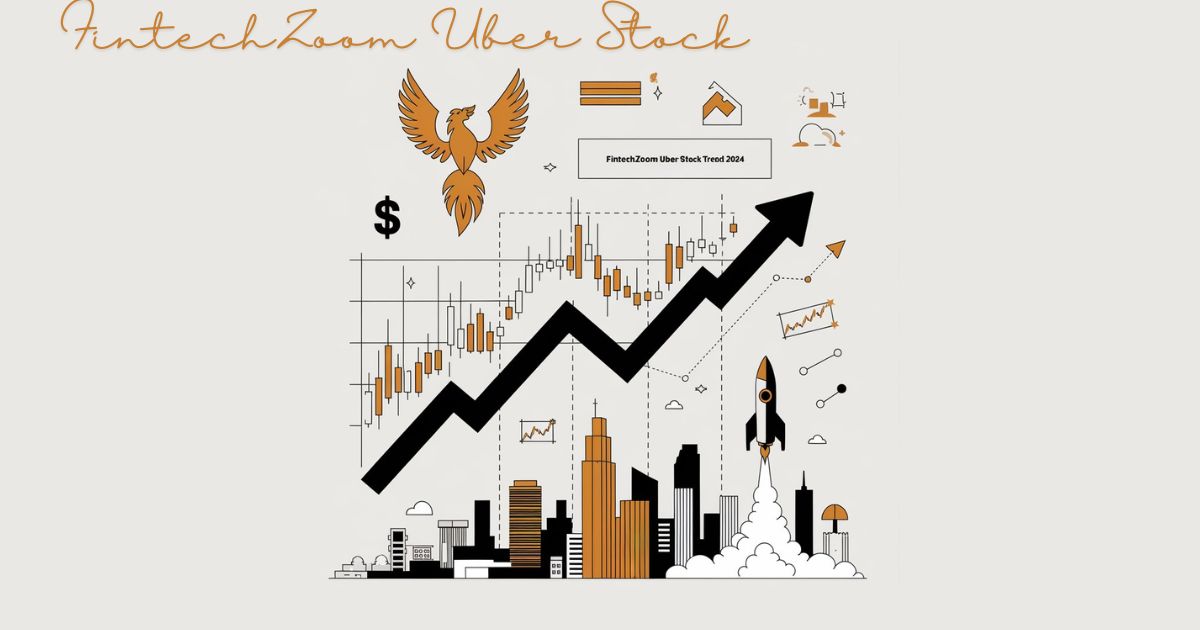In the ever-evolving landscape of tech investments, Uber Technologies, Inc. (NYSE: UBER) continues to captivate the attention of investors and financial specialists alike.
As we delve into the FintechZoom Uber stock trend for 2024, we’ll explore the intricate tapestry of factors shaping this ride-sharing giant’s financial future.
From its market leadership to the challenges it faces, this comprehensive analysis will equip you with the insights needed to make informed decisions in the dynamic world of stock market trends.
What Is Uber Stock?
Uber Technologies, Inc., trading under the ticker symbol UBER on the New York Stock Exchange, stands as a colossus in the ride-sharing and mobility sector. As of mid-2024, the stock has been performing robustly, reflecting the company’s strong market position and significant initiatives.
Analysts have rated Uber as a “Moderate Buy” with a consensus price target of $85.44, representing a potential upside of approximately 24.51% from its recent price of around $68.62. This optimistic outlook is underpinned by Uber’s impressive performance metrics in the first quarter of 2024:
- 21% year-over-year increase in trips, reaching 2.6 billion
- 18% growth in delivery segment gross bookings, totaling $17.7 billion
- 4% revenue increase in the delivery segment, amounting to $3.2 billion
These figures highlight Uber’s trajectory of expansion and operational efficiency improvements across its diverse services, including mobility, delivery, and freight.
The stock’s appeal is largely supported by Uber’s multifaceted business model and strong growth prospects, making it a significant player in both the tech and mobility sectors.
History Of Uber Stock

Uber’s journey as a publicly traded company began on May 10, 2019, with its initial public offering (IPO) priced at $45 per share.
This landmark event raised $8.1 billion, valuing the company at approximately $82.4 billion. However, the stock’s debut was marked by volatility, closing its first trading day down at $41.57.
The subsequent years saw Uber’s stock performance influenced by various factors:
- Regulatory challenges: Uber faced scrutiny and legal battles in multiple jurisdictions.
- Competitive pressures: The ride-sharing market grew increasingly crowded.
- COVID-19 pandemic: In 2020, Uber’s core ride-hailing business was severely impacted, leading to a sharp decline in demand.
Despite these obstacles, Uber demonstrated resilience:
- Uber Eats expansion: The food delivery service saw significant growth, partially offsetting losses in the mobility segment.
- Strategic acquisitions: In 2021, Uber acquired Drizly (an alcohol delivery service) and Postmates, bolstering its market position.
- Profitability milestones: By 2023, Uber had achieved several profitable quarters, emphasizing improved operational efficiency and service diversification.
This forward momentum was reflected in the stock price, which experienced growth and garnered positive ratings from analysts.
Also Read This: Retro Bowl Unblocked 66
Benefits Of Investing In Uber Technologies
Investing in Uber Technologies offers several compelling advantages that make it an attractive option for investors seeking exposure to the tech and mobility sectors.
Market Leadership
Uber’s position as a pioneer in the ride-hailing industry grants it significant competitive advantages:
- Brand recognition: Uber’s name has become synonymous with ride-sharing, creating a powerful brand moat.
- Economies of scale: As the market leader, Uber benefits from operational efficiencies and resource optimization.
- Innovation leadership: Uber’s investments in autonomous vehicles, air taxis, and other transportation technologies position it to maintain its leadership and capitalize on emerging trends.
Business Model
Uber’s diversified business model extends beyond ride-hailing, encompassing:
- Uber Eats: The food delivery service has seen exponential growth, especially during the COVID-19 pandemic.
- Uber Freight: This logistics and supply chain solution taps into a growing market, enhancing revenue potential and reducing overall business risk.
This diversification strategy provides stability and resilience, allowing Uber to weather challenges in any single segment.
Technological Innovation
At the forefront of mobility technology, Uber invests heavily in:
- Artificial Intelligence and Machine Learning: Enhancing efficiency and safety of services.
- Autonomous vehicle technology: Positioning for the future of transportation.
- Data analytics: Improving customer experience and operational efficiency.
These investments ensure Uber remains a market leader, capable of adapting to and driving future transportation trends.
Global Expansion
Uber’s operations span over 70 countries, offering immense growth potential:
- Emerging markets: Increasing urbanization and rising disposable incomes drive demand for ride-hailing services.
- Adaptability: Uber’s ability to tailor its services to different regional requirements strengthens its global presence.
This geographical diversification not only spreads risk but also positions Uber to leverage global market trends.
Strategic Partnerships
Uber has forged strategic alliances with various entities:
- Automotive manufacturers: Collaborations for electric and autonomous vehicle development.
- Technology firms: Partnerships to enhance service offerings and technological capabilities.
- Local governments: Cooperation to facilitate regulatory compliance and integrate with public transportation systems.
These partnerships enable Uber to offer a wider range of services, share costs and risks associated with technological developments, and contribute to long-term growth and sustainability.
Strong Financial Performance
Uber’s financial metrics have shown significant improvement:
- Revenue growth: Consistent increase in top-line figures.
- Path to profitability: Focus on operational efficiency and cost management.
- Improved financial ratios: Better metrics boosting investor confidence.
As Uber continues to optimize its operations and improve profitability, it strengthens its financial position, making it an increasingly attractive investment prospect.
Positive Social Impact
Uber contributes to urban mobility solutions and sustainability efforts:
- Reducing private vehicle ownership: Offering accessible and affordable transportation options.
- Environmental benefits: Decreasing traffic congestion and emissions, especially with the introduction of electric and hybrid vehicles.
- Economic opportunities: Providing flexible income sources for millions of drivers worldwide.
By addressing urban transportation challenges and supporting economic livelihoods, Uber plays a crucial role in creating positive social impact, enhancing its reputation and stakeholder relations.
Risks And Challenges

While Uber presents numerous investment opportunities, it’s crucial to consider the risks and challenges the company faces:
Regulatory Challenges
Uber operates in a complex regulatory environment:
- Varying local regulations: Different jurisdictions impose diverse requirements on ride-sharing services.
- Driver classification issues: Ongoing debates about whether drivers are contractors or employees.
- Compliance costs: Adhering to evolving regulations can be expensive and operationally challenging.
These regulatory hurdles can limit Uber’s operational flexibility, increase costs, and potentially disrupt its ability to enter new markets.
Market Competition
The ride-sharing and food delivery markets are highly competitive:
- Rival companies: Lyft in the US and various regional players globally pose significant competition.
- Price wars: Intense competition can lead to reduced margins and increased marketing expenses.
- Driver and rider incentives: Competitors may offer better incentives, potentially eroding Uber’s market share.
Constant innovation and investment are required to maintain a competitive edge, which can strain financial resources.
Labor Issues
Uber’s business model heavily relies on drivers classified as independent contractors:
- Legal challenges: This classification has been contested in various jurisdictions.
- Potential reclassification: If drivers are reclassified as employees, it could significantly increase Uber’s costs due to benefits, minimum wage requirements, and other employee-related expenses.
- Worker satisfaction: Labor disputes and driver dissatisfaction can lead to service disruptions and negative publicity.
Ongoing legal battles and potential changes in labor laws add uncertainty to Uber’s operational costs and flexibility.
Financial Performance
Despite significant revenue growth, Uber has struggled to achieve consistent profitability:
- High operating costs: Significant spending on driver incentives, marketing, and technology development.
- Investment in new services: Aggressive expansion and investments in areas like autonomous vehicles and freight can impact short-term profitability.
- Investor concerns: There’s ongoing debate about Uber’s ability to transition from a growth-oriented company to one that delivers sustainable profits.
These financial challenges can impact Uber’s stock valuation and investor confidence.
Technological Disruption
The development of autonomous vehicle technology presents both opportunities and threats:
- Potential disruption: If competitors develop and deploy autonomous vehicles more quickly or effectively, it could disrupt Uber’s current business model.
- High costs and uncertainties: The development and regulatory approval of autonomous vehicles involve significant expenses and uncertainties.
- Integration challenges: Successfully incorporating autonomous vehicles into Uber’s fleet could reduce labor costs and improve service efficiency, but the transition period may be complex and costly.
The pace of technological advancements and regulatory acceptance will be crucial in determining the impact on Uber’s future operations.
FintechZoom’s Future Prediction For Uber Stock in 2025

Looking ahead to 2025, FintechZoom’s analysis suggests a promising outlook for Uber stock:
Sustained Profitability: Uber is poised to achieve consistent profitability through:
- Strategic cost-cutting measures
- Enhanced operational efficiencies
- Increased focus on high-margin services like Uber Eats and freight logistics
Autonomous Vehicle Integration: Significant progress is expected in the integration of autonomous vehicles:
- Expanded pilot programs in key markets
- Strategic partnerships with leading autonomous technology providers
- Potential for reduced operational costs and improved service reliability
Service Portfolio Diversification: Uber’s service offerings are likely to expand further:
- Deeper integration with public transportation systems
- Enhanced micromobility options (e.g., electric bikes and scooters)
- Potential launch of aerial ride-sharing initiatives like Uber Elevate
Global Market Penetration: Strengthened presence in emerging markets:
- Focused expansion in Southeast Asia, Africa, and Latin America
- Tailored services to meet local needs and preferences
- Strategic partnerships with local entities to navigate regulatory landscapes
Sustainability Initiatives: Increased emphasis on environmental responsibility:
- Expanded electric vehicle fleet
- Implementation of carbon offset programs
- Partnerships with green technology providers
Technological Advancements: Continued investment in AI and machine learning:
- Enhanced operational efficiencies
- Improved user experiences through predictive analytics
- Advanced fraud detection and safety features
Labor Relations Evolution: Potential shifts in driver engagement models:
- Exploration of hybrid employment models
- Enhanced benefits and support systems for drivers
- Investment in driver education and upskilling programs
Financial Ecosystem Expansion: Development of fintech solutions:
- Introduction of financial services for drivers and riders
- Potential launch of Uber-branded payment systems
- Exploration of blockchain and cryptocurrency integration
These projections paint a picture of Uber as an increasingly diversified, technologically advanced, and financially robust company by 2025.
However, it’s important to note that these predictions are subject to market conditions, regulatory environments, and Uber’s ability to execute its strategic initiatives successfully.
Also Read This: Fintechzoom AMC Stock: Insights and Reason Behind AMC’s Surge
Conclusion
As we navigate the FintechZoom Uber stock trend for 2024, it’s clear that Uber Technologies, Inc. stands at a pivotal juncture. The company’s journey from a disruptive startup to a global mobility leader has been marked by both triumphs and challenges. Uber’s strong market position, diversified business model, and commitment to innovation position it favorably for future growth.
However, investors must weigh these opportunities against the ongoing regulatory challenges, competitive pressures, and the company’s path to sustained profitability. The integration of autonomous vehicles and expansion into emerging markets present significant growth potential, but also come with inherent risks and uncertainties.
As we look towards 2025, FintechZoom’s analysis suggests a cautiously optimistic outlook for Uber stock. The company’s ability to navigate regulatory landscapes, capitalize on technological advancements, and successfully diversify its service offerings will be crucial in determining its long-term success and stock performance.
For investors considering Uber stock, it’s essential to conduct thorough due diligence, stay informed about industry trends, and monitor the company’s progress in achieving its strategic objectives. While Uber’s stock may offer significant growth potential, it also comes with the volatility and risks associated with the dynamic tech and mobility sectors.
In the ever-evolving landscape of ride-sharing and urban mobility, Uber continues to drive innovation and shape the future of transportation. As we move forward, the company’s ability to adapt, innovate, and deliver value to both users and shareholders will be key in determining its position as a leader in the global mobility market.
FAQ’s
What is Uber’s stock ticker symbol?
Uber’s stock ticker symbol is “UBER” and it is traded on the New York Stock Exchange (NYSE).
How has Uber’s financial performance been historically?
Historically, Uber has shown significant revenue growth but has struggled with profitability. The company has heavily invested in driver incentives, technology development, and market expansion, which has impacted its bottom line.
However, recent quarters have shown improvement in financial metrics and a path towards consistent profitability.
What are Uber’s main revenue streams?
Uber’s main revenue streams include:
- Ride-sharing services (Uber’s core business)
- Uber Eats (food delivery)
- Uber Freight (logistics and supply chain solutions)
- Other initiatives such as electric bike and scooter rentals
What challenges does Uber face in achieving profitability?
Uber faces several challenges in achieving profitability:
- Regulatory scrutiny and compliance costs
- Intense market competition leading to price pressures
- High operating expenses, including marketing and driver incentives
- Ongoing investments in new technologies and market expansion
- Potential reclassification of drivers as employees in some jurisdictions
How does Uber plan to expand its market presence?
Uber plans to expand its market presence through:
- Strengthening its position in emerging markets like Southeast Asia, Africa, and Latin America
- Diversifying its service portfolio to include public transportation integration and aerial ride-sharing
- Forming strategic partnerships with local entities to navigate regional regulations and preferences
- Investing in new technologies like autonomous vehicles to capture future market opportunities
How does Uber plan to improve its labor relations?
Uber is exploring various strategies to improve labor relations:
- Investigating hybrid employment models that balance flexibility with better benefits
- Enhancing support systems and resources for drivers
- Investing in driver education and skill development programs
- Improving communication and engagement with the driver community
- Exploring technology solutions to optimize driver earnings and work conditions
What are the growth prospects for Uber stock?
The growth prospects for Uber stock are generally considered positive, based on:
- The company’s strong market position and brand recognition
- Diversification of services beyond ride-sharing
- Potential for expansion in emerging markets
- Investments in future technologies like autonomous vehicles
- Improving financial metrics and path to profitability
- Growing global demand for ride-sharing and delivery services
However, investors should be aware that these prospects are subject to various risks, including regulatory challenges, market competition, and broader economic factors. As always, it’s advisable to conduct thorough research and consider your individual investment goals before making any investment decisions.

Jordan Blake, known at Techycrafted.com, is a veteran expert in the audio, tech and gaming industries. With a passion for innovation and experience in digital media, Jordan provides in-depth reviews and analysis for both tech enthusiasts and gamers alike.











